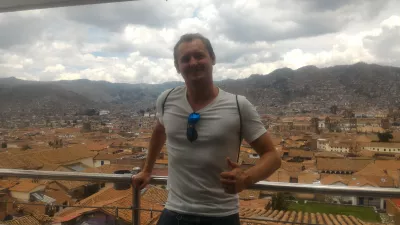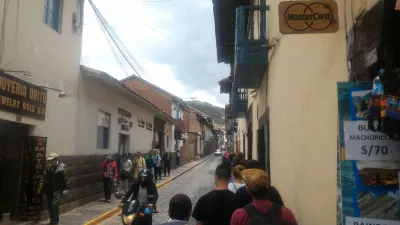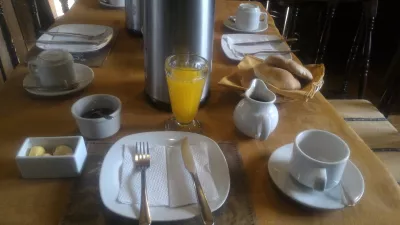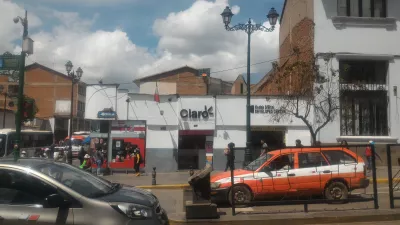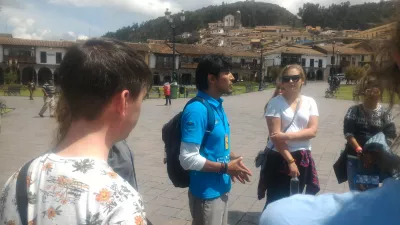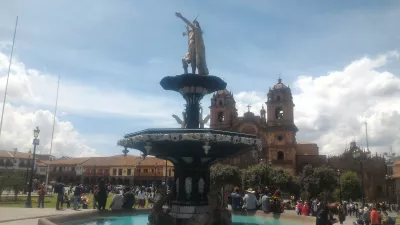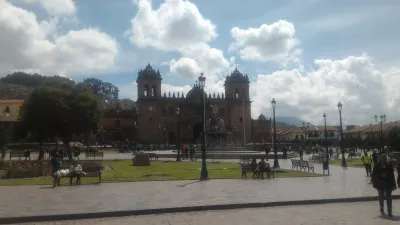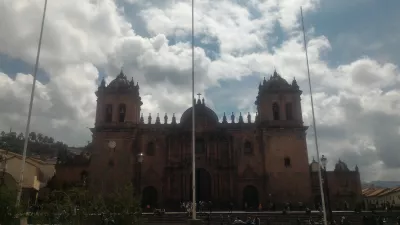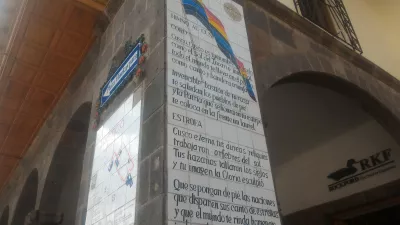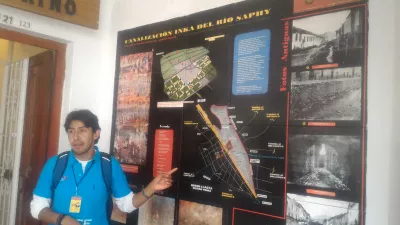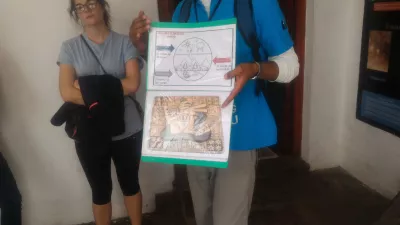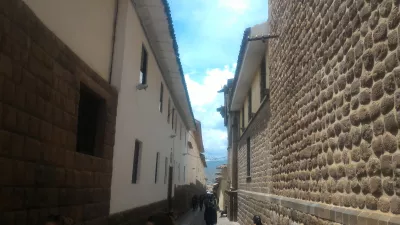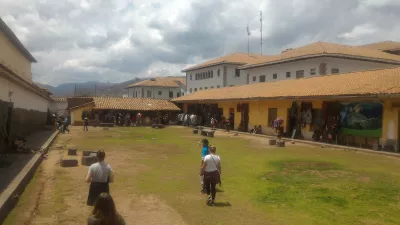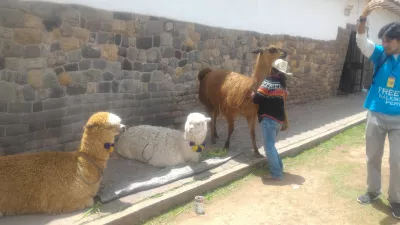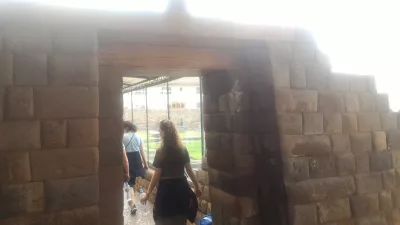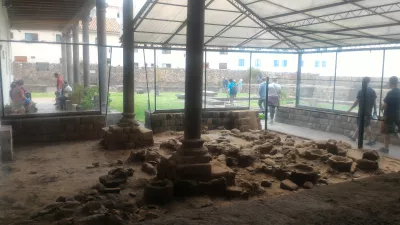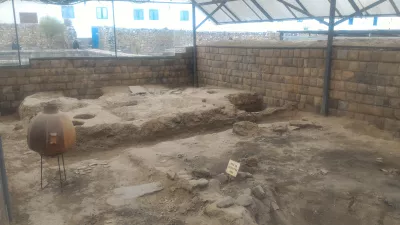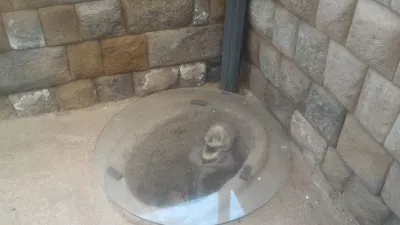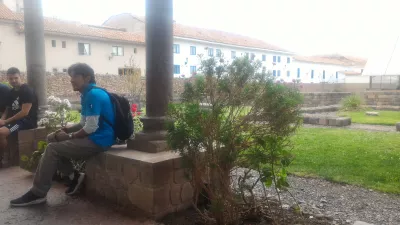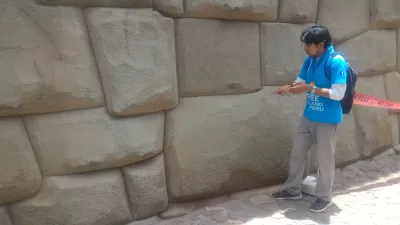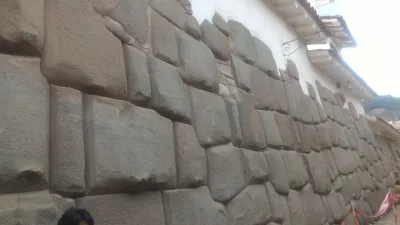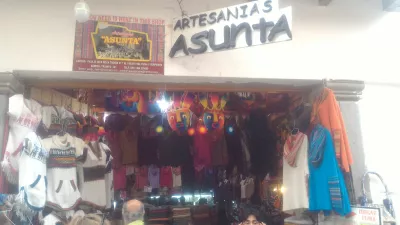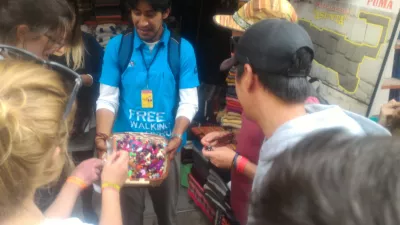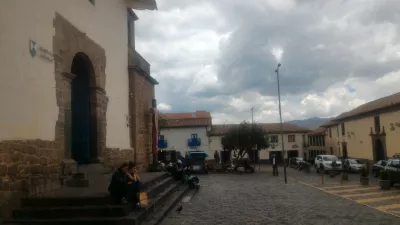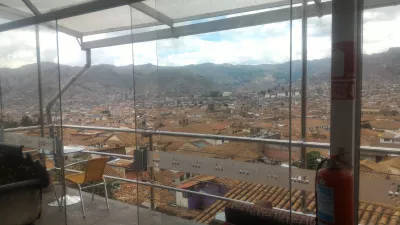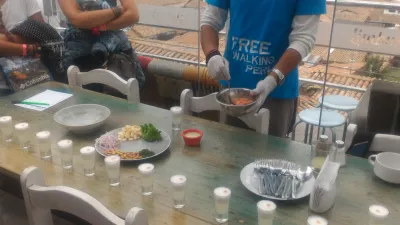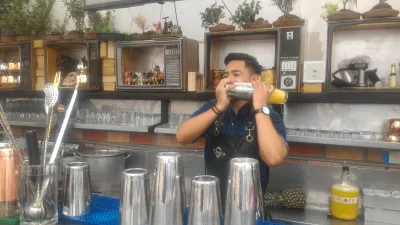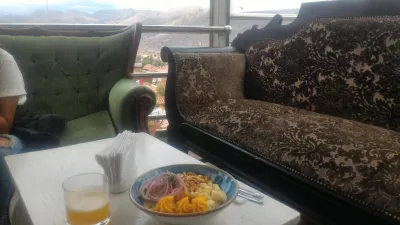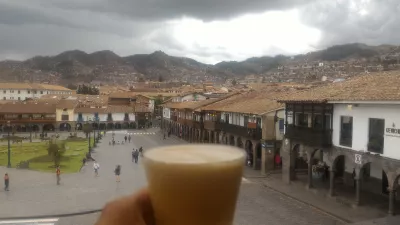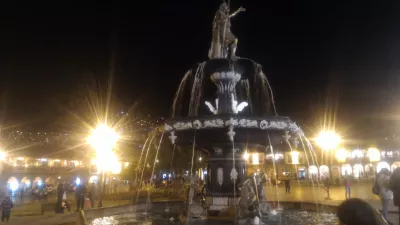How Is The Free Walking Tour In Cusco?
Walking tours Cusco
As I had a great first walking tour experience in Bogotá a week ago, I've decided to use my first full day in Cusco for a walking tour. With Cusco altitude of 3340 meters, a walk was a good idea to acclimate, as I've never been that high.
Before getting there, I had a look on-line for the free tours by foot Cusco, and registered to a walking tour that looked good.
But, arriving at my hostel in Cusco, they had fliers for another walking tour, which looked as good as the other one at first sight.
- 10 best multi-tours day tours visiting Cusco
- Visiting Cusco: The heart of the Inca empire
- Book your free walking tour in Cusco
- Places to stay in Cusco for remote workers – Nomad Stays
Having a look at their website, they did look more professional, more organized, and had a sister company organizing tours, which actually have the best prices on Internet for what I wanted to do, one day rafting (50$ without commission, again 55$ at another agency plus 5.5% credit card commission, or even more at other agencies), and one day Machu Picchu (260$ without commission, against 299$ at my hotel or 305$ plus 5.5% commission at another on-line agency).
Therefore, I changed my mind and finally went with them, which was an awesome choice!
Hostel Cusi Wasi CuscoWalking tour Cusco
I started the day with the first breakfast at my hostel, which was fine, but not exceptional, in contrary to what I've read on-line. One juice, one coffee, 3 pieces of bread, butter, jam, and eggs. Well, I might be a bit difficult because I'm just after 5 days in a 5 start hotel in Bogotá.
After the breakfast, it was time to go to join the walking tour. The meeting was supposed to be at 10 am at the main square, but before arriving, I wanted to buy a local SIM card, in order to have Internet and be able to communicate through my week in Peru.
I was told I might find mobile phone operators on the main square, which was not the case. However, going around, I finally found one Claro office that was selling prepaid SIM cards. I bought one (S/5, 1.5$, 1.3€) with 3GB (S/30, 9$, 8€), which is a pretty good deal.
This small adventure made me wait enough time to be 5 min before the beginning of the tour. I easily found the guides, as advertised on their website, wearing blue polo and the logo of their website.
They proposed me to choose in which group I want to be, the English speaking group or the Spanish speaking group. I chose to go to the English speaking one, to be sure to understand everything.
Plaza de Armas
Starting on the armoured square (arms square, or however you translate it =), we had a quick explanation on what the square was about.
It used to be the main square, even before the Spanish people arrived here and basically destroyed culture and traditions.
Our guide was not hiding his Incas roots, and told us the tour would be mostly about the Inca period, which is actually a great news. Cuzco was once a large city in the Inca civilization, as it was the capital and the center point of the empire.
So, during the old Inca time, the place had a name in Quechua, the Inca language, that means the happy square.
It was the place where they help all kind of celebrations, and therefore was named that way.
Then, when the Spanish arrived, the happy square was renamed the sad square, as it wasn't that fun any more to hang around.
And, finally, after the Spanish finished hispanicizing the city, it became the Arms Square, where the army holds a show every Sunday morning, including the flag raising with the city anthem.
He invites us to come to watch it next Sunday, and tell us to look above : the lyrics of the city anthem are written there. He explains us that Quechua language is gaining more ground, and that in a few years the anthem might be sang in Quechua, and not in Spanish any more, as the old language starts to be taught in schools again.
There is also a flag, which looks very much like the LGBT flag, except for one difference: it has one more colour.
He explains us that this is the city flag of Cusco, and the colours are also meant to symbolize the rainbow.
Cusco former town
We keep walking, and stop under an arch, in front of some sign from the city town.
The guide tells us that the picture shown there are telling us about the former Inca town, which is actually right behind us.
That's right, the Spanish had built there houses on top of the old Incas foundations, and the whole city has been lifter about 2m.
There used to be 2 rivers in the city, which are now underground, in these 2 meters, along with the former Inca town.
Furthermore, he explains us that it infuriates him that it is impossible to dig for this old town, as the digging would destroy the protected colonial style buildings which are now on top of them.
A difficult situation for sure... but he promises us that the Inca city isn't just a dream, and that he's gonna prove us it does really exists and is worth caring about.
We keep walking, and stop in the middle of a small street.
Look on both sides: don't you see? On the left side, the stones are perfectly fitting together, like a puzzle – this is Inca construction, on top of which the Spanish built their colonial houses, given the strength of these foundations. On the right, they are assembled together with mortar in between, this is Spanish style.
We then suddenly go under a small passage, and enter a large courtyard with many local sellers all around.
In one corner, a lady with three animals: we will learn that 2 of them, with short necks, are alpacas, and the other one is a lama. First time I see any of them! We are allowed to pet them, they are so cute and soft. He tells us we should definitely come back and spend more time to take pictures with them, these ones are good ones.
Inca ruins
Continuing the tour, we again suddenly enter a building. And here we are! We are surrounded by real Inca constructions, excavated from earth.
We go inside the free entry museum, and stop on the grass, where we get more explanations about the place.
It appears to be the only Inca archaeological site in the city of Cusco, which used to be the capital of the Inca empire, and the center of their world.
And yet, the only visible remains is this site, which is about a hundred square meters, and is really beautiful.
It is the morning, and Diego, our guide, explains us that if we come later, we might see archaeologists at work on the site.
And, wait, do you know what? It's so good that we took this tour, because our awesome guide knows about these hidden - and free to enter - gems, unlike other tourists. The place is surrounded by glass walls, and look: there are plenty of tourists taking pictures from behind the walls, simply because they don't know that they can come in for free in this amazing Inca outdoor archaeological site.
Anyway, we continue by going under a sun and rain protected area. In the middle, we can see that some excavations had been recently taking place, and a huge amphora sits in the middle : it has been excavated recently, a full huge amphora, that was able to hold many litres of chicha, the traditional South American corn alcohol.
Additionally, look in the corner: there is a huge hole, in which a human sacrifice had been excavated and placed on another hole at a more visible corner, where we could see it. A teenager girl which had been sacrificed to the Inca gods in the old times, probably to calm the mother Earth after an earthquake.
We then take a minute to sit down on the side of the museum, and Diego tells us about the Inca foods, which are mainly corn, potatoes, quinoa, maca, coca. Very interesting! He tells us many anecdotes, which are worth going on the tour.
Inca walls
Afterwards, we keep walking in the town of Cusco - is it the old town? Or just the town? Not sure, but anyway everything around is beautiful.
We suddenly stop right next to huge Inca style foundations.
We take time to admire, and try to understand this question that has never been answered yet: how could the Incas build such perfect rocks combinations, between which a sheet of paper would fit, without using any mortar of any kind?
And how could they anyway, even if we understood how they moulded the stones, move them on around 25km of mountainous land? Stones which are up to hundred of tons?
Without horses, or any mechanical engine? All they had was lamas, which refuse to hold more than 50kg... therefore making it impossible for them to carry a stone that size.
We look at the stones, wonder, and listen to some theories from Diego.
Looking closer, it makes no sense. Some stones, huge ones, are not only cut straight, but have some curves, which are perfectly fit by other stones.
We go around the corner of this amazing building, and Diego introduces us to a shop owner, which seems to have an amazing selection of traditional Peruvian stuff, along with great prices.
She offers us her business card, and a gift, which is pretty awesome – Diego surely knows how to make a tourist group like him;)
We turn around to the wall, and he asks us a question: can we spot the puma, one of the 3 sacred Inca animals, on the wall?
One person in the group finds it, and it then seems obvious to all of us. However, it might be a coincidence, and not necessarily be on purpose.
San Blas district
Heading up the hill, we start sweating a bit, with lot of stairs and steep streets.
We stop in the middle of a square, San Blas, and Diego tells us this is the place to come to party.
It is pretty safe, as police officers are patrolling around at all time, and there are security cameras at every corner, as we can verify by ourselves.
We keep going up, and Pedro takes us to his favourite bar Limbus RestoBar, where he insures us the view on the city will be amazing.
Entering the bar, he was right! We all need a few minutes to take a few pictures with this incredible view, which we are very happy to see at the end of this tour in the small streets of Cuzco.
After we all get our pictures, we get a cooking lesson from Pedro, he is making for us, live, a Peruvian ceviche with trout, which is probably the most well known Peruvian food.
While the trout is cooking in the sauce, we enjoy a free shot of Pisco Sour, which tastes awesome, and is a great way to end up this amazing tour.
The ceviche being ready, we all get to try it, and that is how the tour ends.
Diego is available to any other question or tip about the city, which is very welcomed by most of us.
It was also the occasion to leave him a tip, which he definitely deserved. The tour is free for all to join, but the guides are professional and it’s their way to live, therefore the price is not fixed. I gave him S/30 or about US$8 / 7EUR for having joined this amazing free walking tour in Cusco, which was well deserved.
Limbus RestoBar
He also tells us that is we put a review on TripAdvisor, we can get a complimentary Pisco Sour cocktail from the Limbus RestoBar.
Well I left a review to get the cocktail and help them, I have some of the highest rated profiles on that website... but it is a terrible review website, better see them on WhereCanIFLY? or other websites with real people reviews =)
In any case, that restaurant was awesome and was a great place to enjoy a cocktail.
As the cocktail was so good, I tempted myself with their ceviche, which they insured me was even better than the one we tried that has been cooked live by our guide Diego, and it was definitely the case!
Not being a big fan of ceviche or seafood in general, this was simply awesome, and definitely worth the price of S/25.
Limbus RestoBar the best view in CuscoBloody Bueno Peru
After that, I headed to the sales office of the walking tour brother company, Bloody BUeno Peru, which organized tours.
On the way, I stopped to a few travel agencies to ask about the prices, and be able to compare, already knowing the prices offered by the agency of my hostel.
When I had a look at their website, they had the best prices of what I could see on Internet. Now, getting there, and talking to them, I just got an awesome deal!
What was a 500$+ trip on which I was highly hesitating, became a nice ~400$ with all included that I wanted to do, which is, in order of priority, rafting, ATV, sacred valley, rainbow mountain, and Machu Picchu.
Things to do in Cusco
These are the prices I got, coming from the free walking tour:
- Vinicunca rainbow mountain day trip for S/80 (24$ / 21€),
- Rafting day trip for S/120 (36$ / 31€),
- Machu Picchu day trip for 239$ (207€),
- ATV half day trip for S/100 (30$ / 26€),
- Sacred valley trip for S/60 (18$ / 15.5€).
For ATV and Sacred Valley, an extra ticket has to be bought to enter this archaeological area, which costs S/70 (21$ / 18€) for 1 day, or S/130 (39$ / 34€) for 10 days.
Now, the first of them in my visitperu, the rainbow mountain, starts tomorrow at 04:30, it is nearly 8pm, and time to go to sleep to enjoy next day!
- Bloody Bueno Peru website
- Free walking Peru tour
- Cusco rainbow mountain tour
- Book your free walking tour in Cusco
- 10 best multi-day tours visiting Cusco
Frequently Asked Questions
- What historical and cultural sites does the free walking tour in Cusco cover, and how does it enhance the visitor experience in the city?
- The free walking tour in Cusco covers key historical sites like the Plaza de Armas, Qorikancha, and local artisan markets. It enhances the experience by providing historical context, cultural insights, and personal anecdotes from knowledgeable local guides.
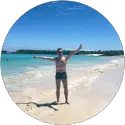
Michel Pinson is a Travel enthusiast and Content Creator. Merging passion for education and exploration, he iscommitted to sharing knowledge and inspiring others through captivating educational content. Bringing the world closer together by empowering individuals with global expertise and a sense of wanderlust.

